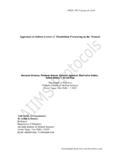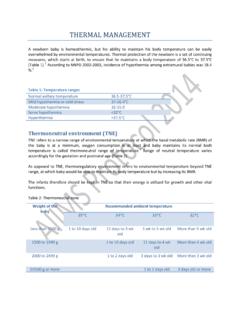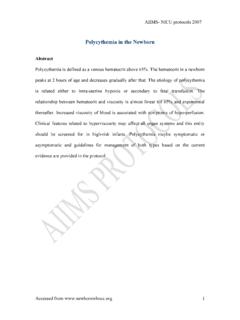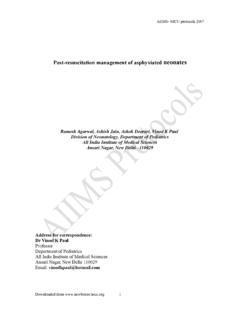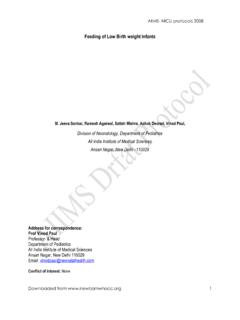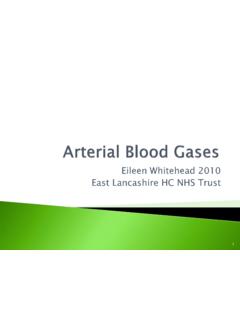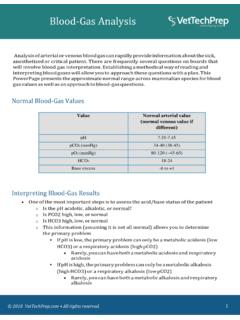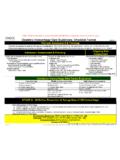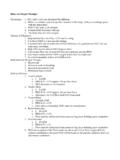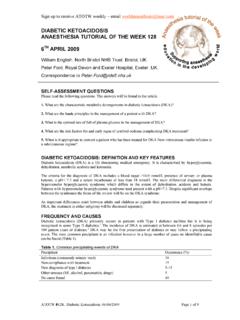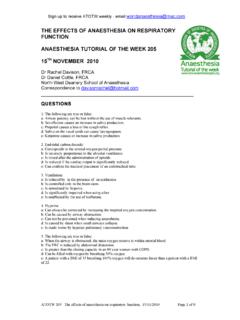Transcription of BLOOD GAS ANALYSIS - Newbornwhocc
1 Deorari , AIIMS 2008 BLOOD GAS ANALYSIS Deorari , AIIMS 2008 2 Contents 1. Introduction, indications and sources of errors 2. Terminology and normal arterial BLOOD gases 3. Understanding the print outs 4. Details about (i) pH (ii) Oxygenation, oxygen saturation, oxygen content, alveolar gas equation, indices of oxygenation (iii) Carbon dioxide transport, Pco2 total CO2 content, and bicarbonate levels (iv) Base excess and buffer base 5.
2 Simple and mixed disorders 6. Compensation mechanisms 7. Anion Gap 8. Approach to arterial BLOOD gases and exercises 9. arterial BLOOD gases decision tree 10. Practical tips for sampling for ABG. Deorari , AIIMS 2008 3 Abbreviations ABE Actual base excess ABG arterial BLOOD gas AaDO2 Alveolar to arterial oxygen gradient Baro/PB Barometric pressure BB Buffer base BE Base excess BEecf Base excess in extracellular fluid BPD Bronchopulmonary dysplasia CH+ Concentration of hydrogen ion CO2 Carbon dioxide ECMO Extra corporeal membrane oxygenation FiO2 Fraction of inspired oxygen HCO3 Bicarbonate H2CO3 Carbonic acid MAP Mean airway pressure O2CT Oxygen content of BLOOD PaCO2 Partial pressure of carbon dioxide in arterial BLOOD PaO2 Partial pressure of oxygen in arterial BLOOD pAO2 Partial pressure of oxygen in alveoli
3 PH2O Water vapour pressure PPHN Persistent pulmonary hypertension in newborn RBC Red BLOOD corpuscles Deorari , AIIMS 2008 4 RQ Respiratory quotient Sat Saturation SBE Standard base excess St HCO-3/SBC Standard bicarbonate TCO2 Total carbon dioxide content of BLOOD THbA Total haemoglobin concentration UAC Umbilical artery catheter Deorari , AIIMS 2008 5 The terminology of arterial BLOOD gas (ABG) is complex and confusing.
4 It is made worse by the printouts generated by recent microprocessors. Basically the machines 10 15 20 25 30 35 40 50 60 70 80 90 100 110 120 130 140 150 Pco2 mm Hg pH Base Excess mEq/I BLOOD or plasma HCO3 mEq/I Plasma Total-CO2 mMol/I Plasma +30 +25 +20 +15 +10 +5 0 25 20 15 10 5 0 -25 -30 -20 -15 -10 -5 0 Hemoglobin g/100 ml 60 50 40 35 30 25 20 15 10 9 8 7 6 4 3 5 6 7 8 9 10 15 20 20 30 35 40 50 60 Deorari , AIIMS 2008 6 measure pH, carbon dioxide and oxygen. All other parameters are derived based on software in machine which can be obtained manually if one knows how to use Siggaard ndersen Nomograms (given above).
5 Goals of ABG in newborn is to characterize the type of disorder, quantify the magnitude and assess the nature and extent of compensation. Indications for ABG (1) Severe respiratory or metabolic disorders (2) Clinical features of hypoxia or hypercarbia (3) Shock (4) Sepsis (5) Decreased cardiac output (6) Renal failure (7) Ideally any baby on oxygen therapy (8) Inborn errors of metabolism Collection of Samples Ideal artery for sampling in newborn is radial or umbilical artery. One must perform Allen Test to ensure collateral BLOOD supply by ulnar artery before puncturing radial artery. If sample from umbilical artery catheter (UAC) is being taken, one should assure free flow of BLOOD and remove three to four times dead space volume before sample is taken.
6 Indwelling arterial line may only be put if round the clock facilities for ABG estimation are available considering this as a potent source of infection. Deorari , AIIMS 2008 7 Arterialised capillary samples are comparable to arterial BLOOD (Table I). If capillary sample (100-150 micro L) is being taken from prewarmed heel, let the capillary fill from the tissue site from where BLOOD is oozing out (figure I). Avoid squeezing and first drop of BLOOD . Rotate the capillary in palm . to mix anticoagulant with BLOOD .
7 Care should be taken not to include any air bubble in the capillary. Venous BLOOD is good for HCO-3 estimation but bad for pH, pCO2 and pO2. While drawing venous sample make sure that no tourniquet is applied, artery is not compressed and sample is drawn against the flow of BLOOD towards heart. Table I : Comparison of BLOOD Gas ANALYSIS at different sites arterial Capillary Venous PH Same ---------- Lower PO2 Higher Lower PCO2 Lower Higher HCO-3 Same ---------- Same Recommendation Good Fair Bad Precautions for collection of BLOOD sample (1) Heparin is acidic and lowers pH.
8 Use heparin of lower strength (1000 units per ml instead of 5000 units per ml) or heplock solution. (2) Use small volume of heparinised saline just for lubricating syringe and plunger. If volume is more, dissolved oxygen in haparinised saline may increase pO2. (3) Avoid air bubble and let syringe fill spontaneously. (4) It is desirable to use a glass syringe as plastic syringes are permeable to air. Deorari , AIIMS 2008 8 (5) Sample may be collected in a heparinised capillary from hub of needle used to puncture artery.
9 The sample should be processed immediately, preferably within 30 minutes. BLOOD is a living medium. The cells consume oxygen and produce CO2. Drop in pO2 depends on initial pO2. If the latter is very high, significant drop may be noticed. The changes are as depicted in Table II. Slush of ice (not cubes) should be used for storing samples till processing. The sample should be shaken, homogenised before putting in machine. Table II: Changes in ABG every 10 minutes in vitro 37 C 4 C pH pCO2 mm Hg mm Hg pO2 mm Hg mm Hg * It is obvious that BLOOD sample should be stored at 4 C, if it cannot be processed immediately for minimal error.
10 Terminology of ABG Acidosis pH < Alkalosis pH> Hypercapnia pCO2 > 50 mm Hg Hypocapnia pCO2 <30 mm Hg Hypoxia pO2 < 50 mm Hg Hyperoxia pO2 > 70 mm Hg *Acidemia and alkalemia refer to BLOOD while acidosis, alkalosis to tissue pH. Deorari , AIIMS 2008 9 Normal Neonatal ABG values PH pCO2 35 45 mm Hg pO2 50 70 mm Hg HCO3 20 24 mEq/L BE 5 ABG values vary with age of neonate and even with gestational age (Table III, IV). Table III: ABG values based on neonatal age Pre-birth 5 min 1-7 days (Scalp) after birth after birth pH > pCO2 <50 35-45 35-45 pO2 25-40 49-73 70-75 Sat% >50 >80 >90 HCO3 >15 16-19 20 Deorari , AIIMS 2008 10 Printout generated by BLOOD gas machine Deorari , AIIMS 2008 11 Table IV.

